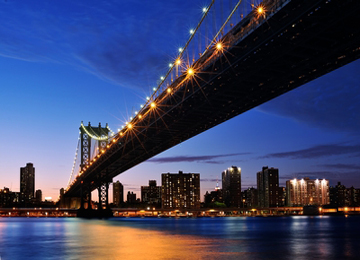
Blog
The City: Cross-
Pollination
and Culture
By: Rebecca Locke
Reading the New York Times online, my eyes drifted to a headline at the bottom of the page, lodged in the section for articles culled from the far reaches of the internet. With distractions like that, the next thing you know you’re getting an education on what can be bought from vending machines in Japan, or learning how to make a little girl’s ponytail using a vacuum cleaner. But I digress…there it was, an otherworldly title: Most Saintly Places to Live in America and I caught myself thinking, “They’re not going to pick it, but it’s got to be New York” Various factors tipped it, though, and lo and behold, New York City came on top. It’s not such a new thing to value the city like this. In his talk, The City, Tim Keller paraphrases the beginning of Psalm 107: “These poor people,” the psalmist seems to say, “they don’t live in a city.”
There is something to be said for “the city” and even more for a well-functioning city. It is, I suspect, in part something about the interaction of people. The title of Julian Temple’s documentary, London – The Modern Babylon, doesn’t use “Babylon” as a synonym for vice and corruption; rather, it alludes to the wonder of a place populated with people from here, there, and everywhere. It is about the cross-pollination of people and ideas. Think about the development of culture and music in postwar Britain this cross-pollination prompted. As migrants moved to London, bringing music and their culture with them, it shaped the development of music and culture in the British Isles—and led to the “British invasion.” Certainly, this idea of the cross-pollination of the city has increasingly been recognized as worth looking into.
In fact, the University of London has a whole department dedicated to the city—The Centre for Urban and Community Research (CUCR) at Goldsmiths, University of London. With “most of the world’s population now living in cities” in mind, it is a department dedicated to the study of cities, where concepts such as urban planning and the lifeblood of cities have been introduced by extraordinary thinkers such as Maliq Simone, Caroline Knowles, Paul Halliday, and Les Back. But not only that, it is an inter-disciplinary research center, meaning urbanists, sociologists, anthropologists, researchers and academics from across disciplines and countries rub shoulders with architects, filmmakers, photographers, and artists also based in the department—an arrangement that itself echoes that quintessential characteristic of the city: cross-pollination, the interaction of people from very different backgrounds, experiences and professions.
Goldsmiths is primarily known for being a forward-thinking arts and humanities school where a number of noted artists studied (alumni include Damien Hirst, Steve McQueen, John Cale, Lucien Freud, and Mary Quant). I was privileged to study there and develop my art practice immersed in an environment alongside others grappling to understand the city. Such a department creates an opportunity for people from various fields to develop their thinking as they are challenged and informed by working alongside peers from other professions. In the development of art practice, students were prompted to make work informed by theory, imparting this discipline to the project-making process.
This value of pursuing a breadth of interaction was touched on by Steve Jobs in his commencement address at Stanford University in 2005. He told a story of how, after dropping out of his studies, he carried on attending classes in subjects he never before had a chance to pursue, that might not have appeared useful, including calligraphy. But nothing was wasted: It gave him an insight into beauty, specifically the beauty of well-crafted typography, and many years later this informed the development of design and fonts for the Apple computer, helping make the Mac a game-changer.
So, what about the cross-pollination of art with urban research? When I left New York for Goldsmiths I returned to my hometown Bognor Regis, located on the southern English coast. Bognor is a British seaside resort, formally a destination of choice for Londoners, now a place with a name synonomous for ìnot the place to be.î Seeing Bognor with fresh eyes, I brought images to critiques that garnered interest amongst my contemporaries, and as an attempt to create a new narrative to challenge the “myth of place”, made the series Brooklyn / Bognor. Around this time I attended a public Town Hall meeting held at the conference center at the iconic seaside resort Butlins, where developers, elected officials, local government officers, and city planners outlined a plan for Bognor’s regeneration. I had been studying the development of cities and said something that must have been interesting enough, for a departmental director from the local authority asked to meet to discuss ideas. Following this, he met with specialists at CUCR at the University of London and was introduced to The Glass-House, an architectural organization that facilitates community-led design. The Glass-House devised a new program tailored for the local government and came to train their officers. Goldsmiths invited me to develop an international symposium in London, with a focus on Bognor Regis, titled City to Sea, drawing attendees from across fields, including architects, urban researchers, planners, photographers, and artists. Back by the sea, the local authority supported a number of public art projects and facilitated a collaboration with Magnum Photos for the City to Sea Magnum Photos workshop with Peter Marlow (the former president of Magnum) at Bognor Regis, hosted by Butlins (interestingly in same exact building used for the Town Hall meeting five years earlier). The work of participants was showcased this October at the Urban Encountersconference at Tate Britain, curated as twelve chapters exploring aspects of Bognor Regis.
Urban Encounters is part of a full-scale international event called Urban Photo Fest, casting its net wide to include symposia at both Tate Britain and the British Library, exhibitions, workshops, walks, radio broadcasts, the launch of a new international association of urban photographers (www.urbanphotographers.org), and an international urban photography competition run with the Royal Photographic Society (RPS). Paul Halliday, the founder and creative director of the festival told me recently ìit was great to see such a response to the ongoing conversation about what art practice and contemporary urban photography looks like when it starts to engage with sociology, geography, history and politics. It was good to see the images from the City to Sea workshop with Magnum being projected in front of an engaged and highly animated conference audience, and events like this underpin the importance of facilitating such opportunities for both established and emerging artists and urban photographers.
Urban Encounters, although developed at the Tate, an international center of art, is the archetype of cross-pollination with “a range of interdisciplinary speakers…from architecture to archaeology, visual arts to geography, highlight[ing] distinctive yet overlapping concerns [and] critical analysis…within the urban context.” It is this urban context that CUCR suggests is so important, “the question of how to understand urban political and economic landscapes and the emerging forms of urban culture” being seen “as perhaps the most pressing issue for the new Millennium.”
Of course, these themes can be explored and expressed through art. Art informed by something, with space for interpretation, is of great cultural value for it can point to potential. A social and cultural potential. It can reveal a beauty hidden in chaos, something of the ordinary can be shown as extraordinary. There is something animating about coming across a work that makes you think. That is why, of all the NYC gallery shows to open this October, Robert Montgomery’s solo show at C24 stood out. His art made one stop and consider.
New York, then, is the place it is because of its people. CFW’s Glimpses – as part of their annual conference – enable participants to see something extraordinary in the city that might not normally be considered or seen. Likewise, when City Rhythms – a CFW program exploring industry trends – highlight a profession there is the potential to impart a breadth of understanding of this city. Who would have thought that such delicate care and thought is put into acoustics in the development of the 2nd Avenue subway, except for hearing from Arup’s Joe Solway. Likewise, the love for the city expressed by the care and foresight of engineer Claire-Elise Orleach in helping to develop the essential water systems for the longevity of a city such as ours, a city surrounded by so much water. Understanding something of the city can maybe make us appreciate it more, better serve it’s people, and, perhaps through these moments of cross-pollination, acquire understanding that maybe, just maybe can lead to new ideas, innovations, and outcomes.
David Byrne puts it this way, “creativity, of all kinds, is the resource we have to draw on as a city and a country in order to survive.” Focusing this further, it is art makes the city “the rich fertile place it has historically been,” and that is the great cultural and social value of art.
More:
www.rebeccalocke.com
www.citytosea.org
www.gold.ac.uk/cucr
www.urbanphotofest.org
Footnotes:
[1] Keller, Timothy J. (2005) The City, October 2, 2005
[2] www.gold.ac.uk/cucr/
[3]
www.tate.org.uk/whats-on/tate-britain/conference/urban-encounters-urban-materialities
[4] www.gold.ac.uk/cucr/
[5] David Byrne (2013) www.theguardian.com/commentisfree October 7, 2013
[6] ibid
